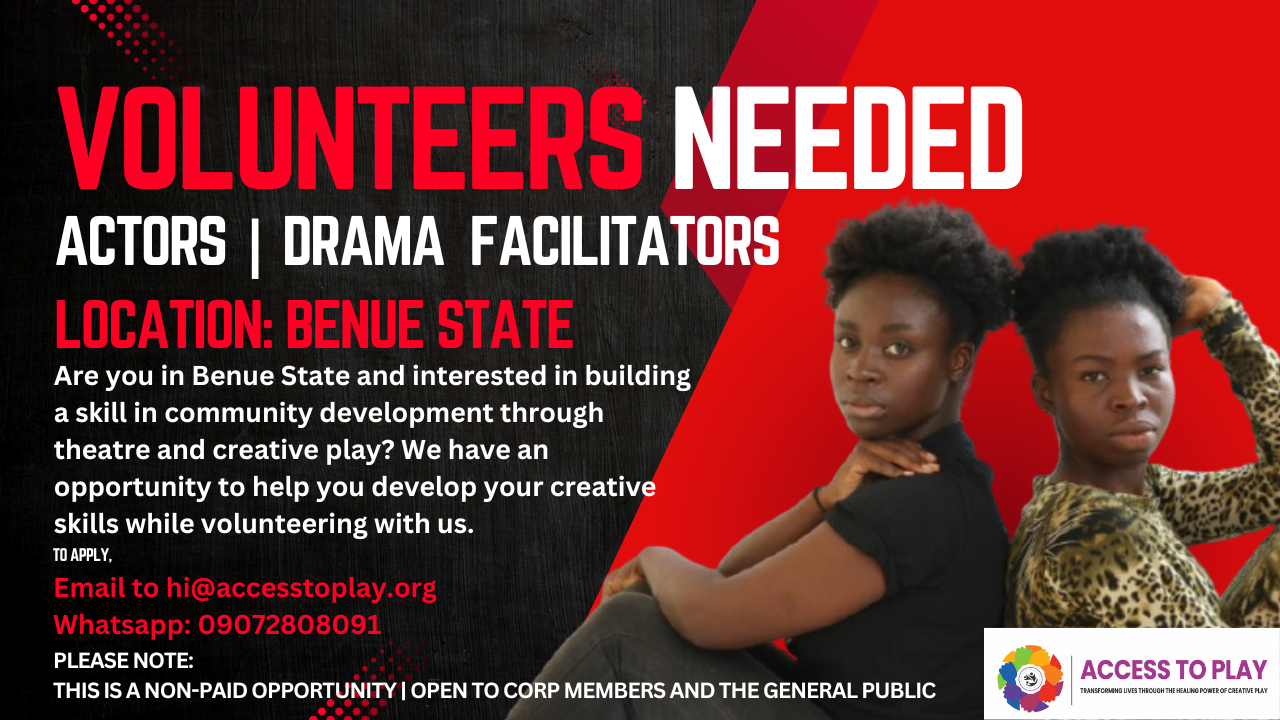
Six Powerful Benefits of Theatre for Social Change: Transforming Communities with Access to Play
Theatre isn’t just for the stage, it’s a dynamic tool for social change.
At Access to Play, we believe in the transformative power of theatre to address some of the most pressing issues facing communities today, from Gender-Based Violence (GBV) to Harmful Traditional Practices (HTP). Theatre for social change doesn’t just entertain; it empowers, educates, and creates real-world impact. Here are six compelling reasons why participating in theatre for social change can transform lives, inspired by the work we do at Access to Play and the global field of applied theatre.
1. Empowering Individuals to Take Action
The beauty of theatre is that it’s not just about passive observation; it’s about active participation. When people engage in a theatrical performance—whether as actors, creators, or spectators—they are empowered to take ownership of the narrative. This is particularly powerful in communities grappling with issues like GBV and HTP. Participants are given a platform to voice their experiences, challenge harmful norms, and, most importantly, take charge of creating the change they wish to see.
For instance, in Brazil, community-based theatre groups like Teatro de Arena use participatory theatre to give marginalized communities a voice. These performances have sparked deep conversations and led to real changes in local policy and community attitudes (Boal, A. “Theatre of the Oppressed,” 1979). At Access to Play, we see this empowerment firsthand as community members learn they have the tools to make a difference—on stage and in their daily lives.
2. Fostering Critical Thought and Reflection
Theatre forces us to think deeply about the issues we care about, and that’s especially true when it comes to social change. By engaging with dramatic scenarios and seeing the consequences of different actions, participants and audiences alike are encouraged to reflect on the root causes of problems like GBV and HTP. This isn’t just about presenting problems—it’s about presenting solutions. Through drama, individuals can step into a variety of perspectives, grapple with moral dilemmas, and ultimately, develop the critical thinking needed to make informed, empathetic decisions in their own lives.
Consider the work done in India by Kolkata Sanved, an organization that uses dance and theatre to help survivors of human trafficking reflect on their past trauma and think about their futures. Through this process, participants critically reflect on the societal forces that led to their exploitation, and gain insight into how they can move forward and heal (Sangram, 2013). At Access to Play, we too use theatre to encourage participants to question existing societal structures and rethink harmful behaviors, creating more open-minded and resilient communities.
3. Building Stronger, More Connected Communities
One of the most profound outcomes of theatre for social change is the way it brings people together. Theatre fosters collaboration, communication, and shared experience. In our workshops, whether in schools, markets, or community centers, participants from diverse backgrounds come together to create something meaningful. This collective effort breaks down barriers, strengthens relationships, and builds solidarity.
In South Africa, Ubuntu Theatre Project engages marginalized communities through Forum Theatre to explore social issues like racism and poverty. These workshops not only raise awareness but also serve as a bonding experience, uniting participants in their shared struggle for justice (Mda, Z. “When People Play,” 1993). Similarly, Access to Play’s initiatives foster a sense of belonging and mutual understanding, helping communities combat GBV and HTP through united, cooperative efforts.
4. Raising Awareness on Key Social Issues
Let’s face it: some of the world’s most crucial issues are also the hardest to talk about. Theatre provides an innovative way to bring taboo subjects like GBV and HTP into the open. Through performance, communities are not only exposed to the realities of these issues—they are invited to engage in meaningful dialogue about them. Theatre is an ideal medium to bring awareness to sensitive topics because it doesn’t just speak at people—it involves them, making them an active part of the conversation.
Take, for example, the Teatro de la Ciudad in Mexico, where performances about femicide and violence against women have sparked nationwide conversations on the systemic causes of violence against women. The performances provided a platform for marginalized voices and brought these urgent issues to the forefront of public discourse (Della, 2014). Similarly, Access to Play’s performances engage audiences to explore how GBV and HTP affect their lives, prompting awareness and action on the ground.
5. Catalyzing Long-Term Behavioral Change
Theatre isn’t just about raising awareness—it’s about changing behaviors. By providing audiences and participants with the tools to critically engage with social issues, theatre encourages them to take actionable steps toward positive change. At Access to Play, we focus on shifting behaviors, not just attitudes. Our workshops and performances actively involve people in solving problems, encouraging them to step up and make a tangible difference in their communities.
In the United States, Augusto Boal’s Invisible Theatre has been used to intervene in everyday spaces, sparking conversations about racial and environmental justice. These performances help participants understand their role in addressing these issues in their daily lives (Boal, A., “Invisible Theatre,” 1979). Similarly, Access to Play’s Forum Theatre workshops give participants the tools to recognize and challenge GBV and HTP when they encounter them, catalyzing real-world behavior change.
6. Creating Safe Spaces for Healing and Dialogue
For many, theatre provides a therapeutic outlet—a way to heal, process emotions, and find solidarity. At Access to Play, we understand the deep emotional impact of social issues like GBV and HTP, and we create spaces for individuals to reflect, heal, and rebuild. Theatre offers a unique form of catharsis, allowing participants to release pent-up emotions, gain clarity, and rebuild their sense of self-worth.
In the UK, Clean Break Theatre uses theatre as a form of rehabilitation for women in prison, helping them process their trauma, reflect on their experiences, and ultimately reintegrate into society. The act of performing becomes a vehicle for healing and self-discovery (McIntyre, 2010). Similarly, our workshops offer survivors of violence a safe space to express their feelings, confront their trauma, and find collective healing through shared performance.
In Conclusion: A World Transformed Through Theatre
Theatre for social change isn’t just a form of entertainment—it’s a movement, a catalyst, and a powerful tool for transformation. Whether in Nigeria, Brazil, South Africa, or the UK, we’ve seen firsthand how theatre empowers individuals, fosters critical thought, and brings communities together to tackle some of the most pressing issues of our time. At Access to Play, we believe that through the power of participatory theatre, we can build a world that is more inclusive, compassionate, and just.
Let’s continue to use theatre as a tool for healing, learning, and social change—one performance at a time.
References:
- Boal, A. (1979). Theatre of the Oppressed. Pluto Press.
- Boal, A. (1979). Invisible Theatre. Theatre Communications Group.
- Della, P. (2014). Theatre for Social Change in Mexico: Raising Awareness About Femicide. Mexico City: University Press.
- McIntyre, R. (2010). Theatre and Prison: Rehabilitating through Interactive Arts. London: Routledge.
- Mda, Z. (1993). When People Play: The Role of Theatre in Social Change. Johannesburg: University of Witwatersrand Press.
- Sangram, K. (2013). Using Theatre for Social Change in India: The Case of Kolkata Sanved. Delhi: Oxford University Press.





